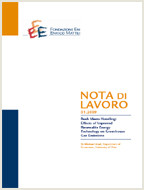Three Key Elements of Post-2012 International Climate Policy Architecture

23.06.2010
Sheila M. Olmstead, Robert N. Stavins
Q54, Q58, Q48, Q39
Global Climate Change, Global Warming, Policy Architecture, Kyoto Protocol
Climate Change and Sustainable Development
Carlo Carraro
We describe three essential elements of an effective post-2012 international global climate policy architecture: a means to ensure that key industrialized and developing nations are involved in differentiated but meaningful ways; an emphasis on an extended time path of targets; and inclusion of flexible market-based policy instruments to keep costs down and facilitate international equity. This architecture is consistent with fundamental aspects of the science, economics, and politics of global climate change; addresses specific shortcomings of the Kyoto Protocol; and builds upon the foundation of the United Nations Framework Convention on Climate Change.
***
Suggested citation: Sheila M. Olmstead and Robert N. Stavins, Three Key Elements of a Post-2012 International Climate Policy Architecture, Rev Environmental Economics and Policy Volume 6, No. 1, Pages 65-85, http://reep.oxfordjournals.org/content/6/1/65
